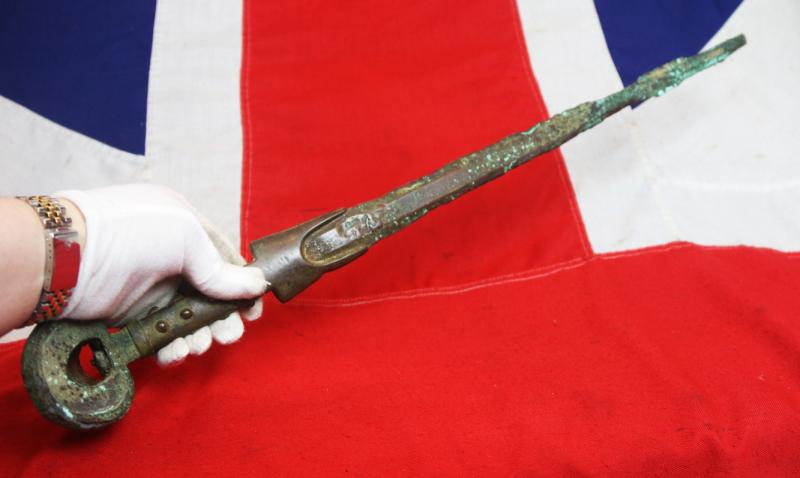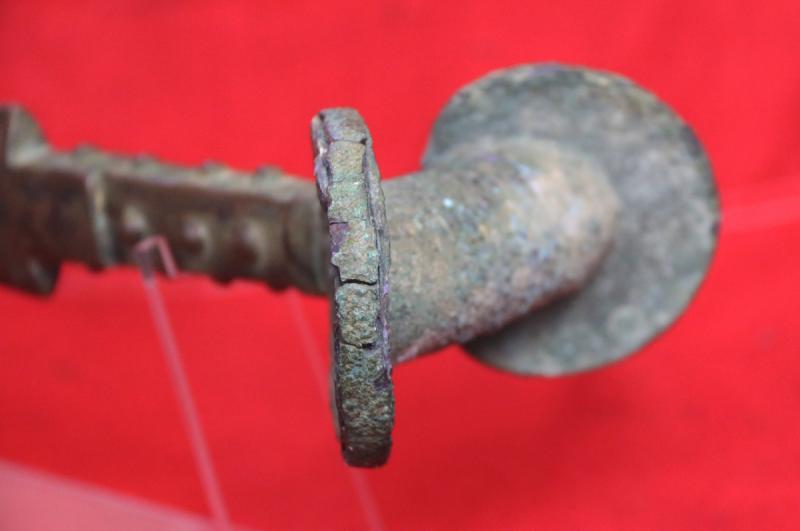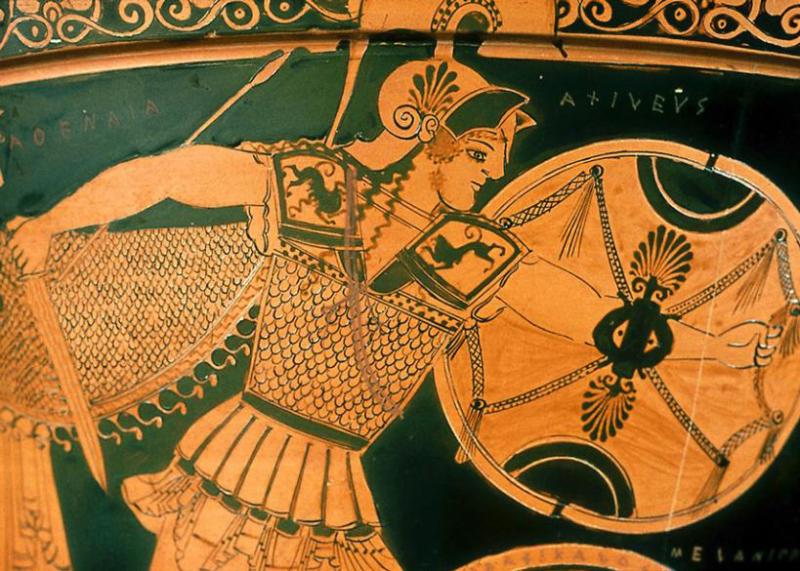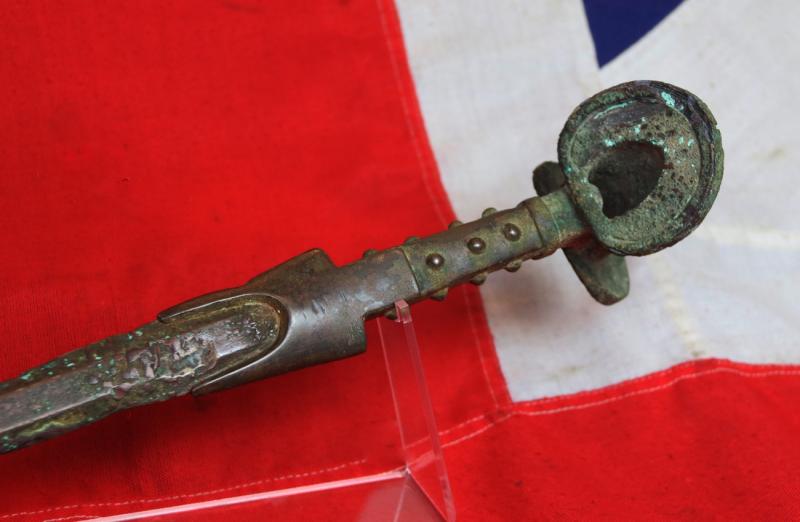A Beautiful & Massive Ancient Bronze Age Long Sword Circa 1200 to 800 BC. As Used From Before and Including the Greco-Persian Wars, Such as the Battles of Marathon & Thermopylae. As Used in Hand To Hand Combat Between Xerxes' Immortals, and The Hoplites
Massive bronze age sword with Double Ear Pommel, 10th-9th Century BC. with partial green encrustations, with some parts of the blade end showing hand to hand combat denting. A sword that was possibly made in around 1200 bc, but expected at the time to have a functioning use of 500 to 600 years or even more. Swords were immensely expensive, and being of bronze easy to maintain and repair, but constant sharpening was also required as they couldn't hold an edge as the much later Iron age sword could.
A magnificent, enormous bronze sword of the “double ear” pommel style, made using the lost wax casting technique by highly trained urban artisans for an elite member of a nomadic horse-riding clan. The blade was cast first, and then the handle was cast onto it - scans of similar swords have revealed tangs inside the handles.
This well-balanced weapon has a slender, square hilt, with raised decorative elements on each of the four sides joining to a pommel that divides into two finely decorated semi-circular “ears” at right angles to the blade. A rectangular guard carefully designed with crescent-shaped horns extends down to firmly grip the upper end of the prominent midrib that tapers regularly with almost straight cutting edges to a point.
The “double ear” style of sword - with both bronze and iron blades - has been excavated from graves in southern Azerbaijan, the Talish and Dailaman regions of northwest Iran, and the urban sites of Geoy Tepe and Hasanlu, also in northwestern Iran. Another, with both bronze pommel and blade, was pulled from the Caspian Sea, where it may have been thrown as an offering. It seems that swords like this example were not just made to be used in battle, but instead to show status or as votive weapons.
There is a strong tradition in the ancient Near East of swords and other weapons being associated with the gods. For example, there is a rock carving dating to circa 1300 BC from this region that shows a scene of the gods of the Underworld, including one who is holding a sword similar to this one. Similarly, a golden bowl excavated at Hasanlu (northwestern Iran) shows three swords of similar form to this one that are associated with three deities from the Hittite pantheon. Whatever its original function, this would have been a spectacular weapon to behold, with a deep, shining surface when polished. Whoever commissioned this sword must have been an elite individual of high status, perhaps seeking to honour the gods by handling such a weapon.
The late bronze age early Luristan culture was renowned for their bronze workmanship and this cast bronze sword is an excellent illustration of their skill. Cast using the lost wax process, this sword is a rare example of the double ear pommel type found in the great museums of the world.
This well-balanced and mighty weapon, is around the same proportions of the much later Roman gladius. It features a slender square hilt that joins to a pommel that divides at right angles to the blade into two finely decorated semi-circular "ears". The pommel features with a semi-circular opening in the centre of each ear. A rectangular guard carefully designed that extends down to firmly grip the upper end of the double-edged blade.
The wide graduated blade that tapers regularly to a point and it has, low, twin central midribs that taper regularly with almost straight cutting edge to a point, making it most suitable for thrusting and cutting.
It is the austere perfection of line and proportion that makes this weapon so beautiful.
This type of pommel represents the north-western Persian version of weapons evolved from Elamite or Mesopotamian flange-hilted blades. They are found made throughout the northern regions of Persia in both bronze and iron, and sometimes with a combination of bronze hilt and iron blade. Items such as this were oft acquired in the 18th century by British noblemen touring Northern France and Italy on their Grand Tour. Originally placed on display in the family 'cabinet of curiosities', within his country house upon his return home. A popular pastime in the 18th and 19th century, comprised of English ladies and gentlemen travelling for many months, or even years, throughout classical Europe, and Middle East, acquiring antiquities and antiques for their private collections. This is a most handsome ancient bronze weapon from the era of the so called Trojan Wars. The ancient Greeks believed the Trojan War was a historical event that had taken place in the 13th or 12th century BC, and believed that Troy was located in modern day Turkey near the Dardanelles. In Greek mythology, the Trojan War was waged against the city of Troy by the Achaeans (Greeks) after Paris of Troy took Helen from her husband Menelaus, the king of Sparta. The war is among the most important events in Greek mythology and was narrated in many works of Greek literature, including Homer's Iliad and the Odyssey . "The Iliad" relates a part of the last year of the siege of Troy, while the Odyssey describes the journey home of Odysseus, one of the Achaean leaders. Other parts of the war were told in a cycle of epic poems, which has only survived in fragments. Episodes from the war provided material for Greek tragedy and other works of Greek literature, and for Roman poets such as Virgil and Ovid.
The war originated from a quarrel between the goddesses Athena, Hera, and Aphrodite, after Eris, the goddess of strife and discord, gave them a golden apple, sometimes known as the Apple of Discord, marked "for the fairest". Zeus sent the goddesses to Paris, who judged that Aphrodite, as the "fairest", should receive the apple. In exchange, Aphrodite made Helen, the most beautiful of all women and wife of Menelaus, fall in love with Paris, who took her to Troy. Agamemnon, king of Mycenae and the brother of Helen's husband Menelaus, led an expedition of Achaean troops to Troy and besieged the city for ten years due to Paris' insult. After the deaths of many heroes, including the Achaeans Achilles and Ajax, and the Trojans Hector and Paris, the city fell to the ruse of the Trojan Horse. The Achaeans slaughtered the Trojans (except for some of the women and children whom they kept or sold as slaves) and desecrated the temples, thus earning the gods' wrath. Few of the Achaeans returned safely to their homes and many founded colonies in distant shores. The Romans later traced their origin to Aeneas, one of the Trojans, who was said to have led the surviving Trojans to modern day Italy. Made in copper bronze in the Western Asiatic region. Western Asiatic bronzes refer to items dating from roughly 1200-800 BC that have been excavated since the late 1920's in the Harsin, Khorramabad and Alishtar valleys of the Zagros Mountains especially at the site of Tepe Sialk. Scholars believe they were created by either the Cimmerians or by such related Indo-European peoples as the early Medes and Persians. Weapons from this region were highly sought after by warriors of many cultures because of their quality, balance and durability.
The Battle of Thermopylae
The first decision, to hold the narrow Vale of Tempe between Macedonia and Thessaly, was abandoned when it was realised that the position could easily be turned. The Greeks then occupied the still narrower pass of Thermopylae with 6,000 or 7,000 hoplites and stationed 271 triremes at Artemisium in northern Euboea. The positions were linked by communication between the Spartan commanders, King Leonidas at Thermopylae and Eurybiades at Artemisium, who intended to halt and damage the Persian forces. Meanwhile, Xerxes was advancing slowly. He made no use of separate columns, and his fleet suffered heavy losses in a storm when it was convoying supply ships along the coast. It was already August when Xerxes began the operations, which extended over three days.
On the first day, Xerxes sent a detachment of 200 ships, unseen by the Greeks, to sail around Euboea and close the narrows of the Euripus Strait. He also attacked with his best infantry at Thermopylae, where the Greeks inflicted heavy casualties. During the afternoon the Greek fleet, having learned about the Persian detachment from a deserter, engaged the main Persian fleet with some success. The Greeks intended to sail south that night and destroy the detachment the next day, but a tremendous storm kept the Greeks at Artemisium and wrecked the 200 Persian ships off south Euboea. On the second day, news of the Persian disaster was brought up by a reinforcing squadron of 53 Athenian ships. Xerxes attacked again with no success at Thermopylae, and the Greeks sank some Cilician vessels off Artemisium.
A Greek traitor, Ephialtes, offered to guide the Persians along a mountain path and turn the position at Thermopylae. The Immortals, a cadre of elite Persian infantry, were entrusted to him. At dawn on the third day, they began to descend toward the plain behind the Greek position. Leonidas retained the troops of Sparta, Thespiae, and Thebes and sent the remainder south. He then advanced. He and his soldiers fought to the death, except the Thebans, who surrendered. Meanwhile, the Persian fleet attacked at noon. Both sides suffered heavy losses, and the Greeks realized that they could succeed only in narrower waters. That evening, when the fall of Thermopylae was known, the Greek fleet withdrew down the Euboic channel and took station in the narrow straits of Salamis.
For reference see: Moorey P.R.S. "Catalogue of Ancient Persian Bronzes in the Ashmolean Museum" (1971), pg. 80 fig 63, Mahboubian, H. "Art of Ancient Iran" pg 304 386(a) & (b) and pg 314-315 397a-I, Moorey PRS "Ancient Persian Bronzes in the Adam Collection" pg 58 28 and Muscarella "Bronze and Iron, Ancient Near Eastern Artifacts in the Metropolitan Museum of Art" pgs 282-285 385-390.
Around 26 inches long overall.
Code: 24766
2995.00 GBP









